
A lottery is a game in which numbers or symbols are drawn at random to determine the winner of a prize. It’s a popular way to raise money for public works, such as roads or bridges, or for private projects like schools or churches. The prize money can also be used to help the poor or to pay off debt. Lotteries are often regulated by state governments.
The concept of a lottery dates back centuries, and the prizes were originally awarded to the winners of an event based on chance. Lotteries were common in the Roman Empire—Nero was a big fan—and are attested to in biblical texts, where they were used to choose everything from the next king of Israel to who would keep Jesus’s garment after his crucifixion. Despite these ancient roots, modern lottery games are more than just a game of chance—they’re also a powerful tool for generating revenue and boosting economic development.
In his book How to Win the Lottery: The Science of Winning the Powerball, Harvard professor and statistician Mark Glickman writes that in the early American colonies, lotteries were a key source of public funds. They helped finance everything from canals and bridges to colleges, libraries, and churches. Harvard, Yale, and Princeton were founded with lotteries, and the Continental Congress even held a lottery to help fund the Revolutionary War.
Lotteries were particularly popular in colonial America because they offered a solution to a pressing problem: state deficits. As Cohen points out, America became “a nation defined politically by an aversion to taxation.” Thus, lottery sales boomed as states searched for ways to balance their budgets without increasing taxes or cutting services—both options that were extremely unpopular with voters.
While most lottery players are speculating on the next jackpot, few are taking advantage of statistical tools that can increase their chances of winning. For example, by analyzing the winning tickets from past drawings, it’s possible to determine the most likely combinations of numbers that will appear in a future drawing. To do this, you can chart the number of times each digit appears on the winning ticket—this is called a frequency distribution. Look for patterns such as repeating digits, or “singletons,” which only appear once on the winning ticket.
Another method is to study scratch off tickets. Purchase a few cheap tickets and experiment by counting the repetitions of each digit on the outside. Then, mark on a separate sheet of paper the spaces where each digit appears only once (the ones). You’ll find that groups of singletons signal a winning ticket 60-90% of the time. It’s a simple, cost-effective way to optimize your odds of winning.